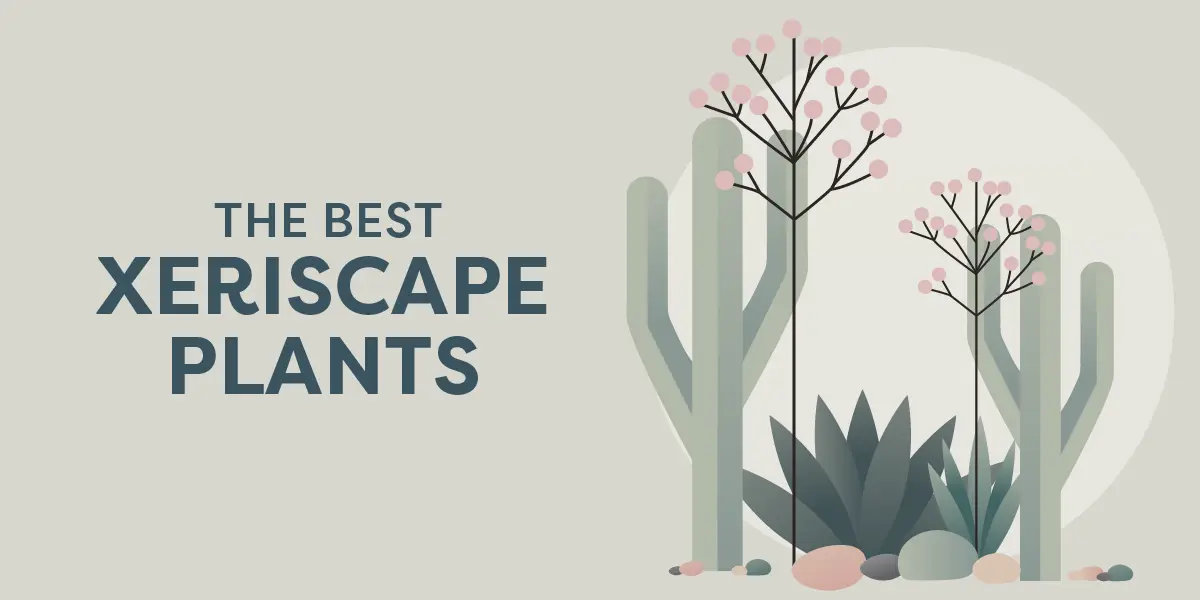Xeriscapes save more than water. They save time, effort, and money because they require so little maintenance.
Plus, a well-designed xeriscape is uniquely beautiful, a standout in a sea of suburban sameness.
In this blog, we’ll list some of the best drought-tolerant plants for a memorable and sustainable landscape in SoCal.
What Is Xeriscaping?
Xeriscaping is a method of landscaping focused on water conservation. It uses drought-tolerant plants, drip irrigation, and thoughtful planning to create a low-maintenance, sustainable yard or garden. Xeriscaping originated in arid regions like the southwestern United States and has become increasingly popular in areas facing water shortages.
The term “xeriscape,” coined by the Denver Water Department in 1981, combines the Greek word for dry, xeros, and the word “landscape.” While it may conjure up images of Lawrence of Arabia in the barren desert, xeriscaping can create a rich, diverse, and environmentally friendly scene.
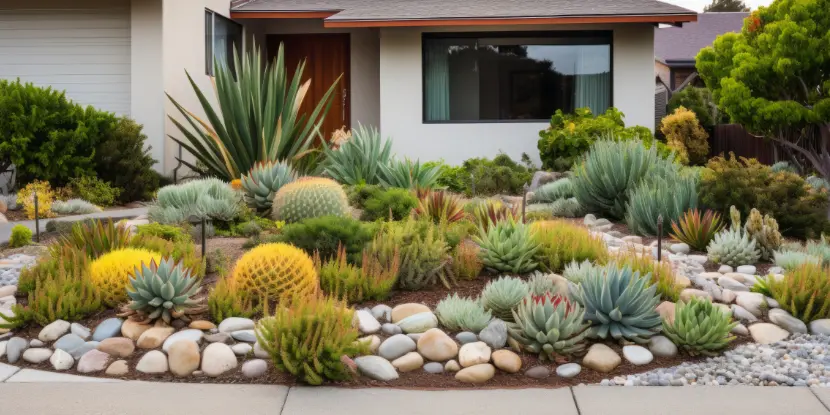
A modern home with a xeriscaped front yard.
Why Xeriscaping?
As mentioned, xeriscaping offers several benefits beyond water conservation:
- Drought-tolerant plants require less pruning, fertilizing, and weeding.
- Native plants require less fertilizer and pest control.
- Xeriscaping saves money. Lower water use means lower water bills.
- Xeriscaping promotes native plants, which support local ecosystems and biodiversity.
- Deep-rooted xeriscape plants stabilize the soil, reducing erosion and runoff during heavy rains.
- Xeriscapes are more resilient than traditional lawns and gardens.
- With the proper selection of plants, colors, and textures, a xeriscape can be just as visually appealing as a conventional lawn and garden — or more.
Planning Your Xeriscape
1. Assess Your Site
- Determine the type of soil in your garden. It will influence plant choice and irrigation methods. Sandy soils drain quickly, while clay soils retain water longer.
- Observe the sun patterns in your space. Note areas that receive full sun, partial shade, or full shade.
- Identify slopes and natural drainage patterns to prevent erosion and water runoff.
2. Design Your Xeriscape
- Divide your landscape into zones based on water needs. Group plants with similar water requirements together to make irrigation more efficient.
- Choose drought-tolerant and native plants suited to your region’s climate and soil. Research plants that thrive in Southern California’s semi-arid conditions.
- Use rocks, gravel, and mulch to reduce water evaporation and add interest to your garden. Paths and patios can lend structure and functionality.
- If you want to include a water feature, choose one that recirculates the water to minimize waste.
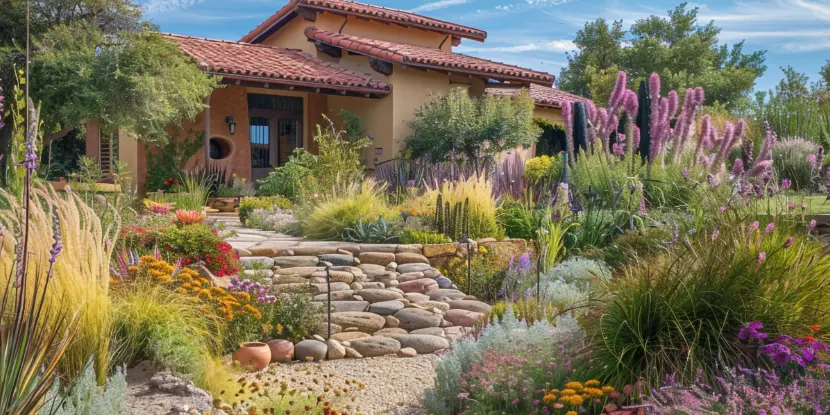
A beautifully designed xeriscaped garden.
3. Irrigation
- Drip Irrigation: Install drip irrigation systems with low-flow emitters to water each plant directly at its root zone. This conserves water and reduces evaporation.
- Smart Controllers: Use smart irrigation controllers that adjust watering schedules based on weather conditions and soil moisture levels.
- Rainwater Harvesting: Consider installing rain barrels or cisterns to collect and store rainwater for later use.
Best Xeriscape Plants for Southern California
Now that you’ve planned your xeriscape layout, it’s time to get down to the nitty-gritty!
Drought-Tolerant Trees
- Valley Oak: A staple in Southern California, this majestic tree offers beauty and shade.
- Coast Live Oak: A majestic evergreen oak found along the California coast.
- California Sycamore: Another large, shade-providing tree with attractive mottled bark.
- Palo Verde: A desert native with yellow flowers and green bark.
- Western Redbud: A small, drought-tolerant tree with lovely pink or purple flowers in spring.
- Ironwood: A small, native desert tree with purple blooms and attractive bark.
- Crape Myrtle: A popular tree with eye-catching blooms and a dense and spreading canopy.
- Mediterranean Cypress: A tall, narrow conifer that adds a vertical element to your xeriscape.
- Piru Queen Palm: A drought-tolerant palm tree with graceful fronds and a slender trunk.
- Desert Willow: A small and delicate tree with beautiful trumpet-shaped flowers.
- Pygmy Date Palm: A slow-growing palm that adds a tropical feel to your landscape.
- Blue Hesper Palm: A drought-tolerant palm with striking blue-green foliage.
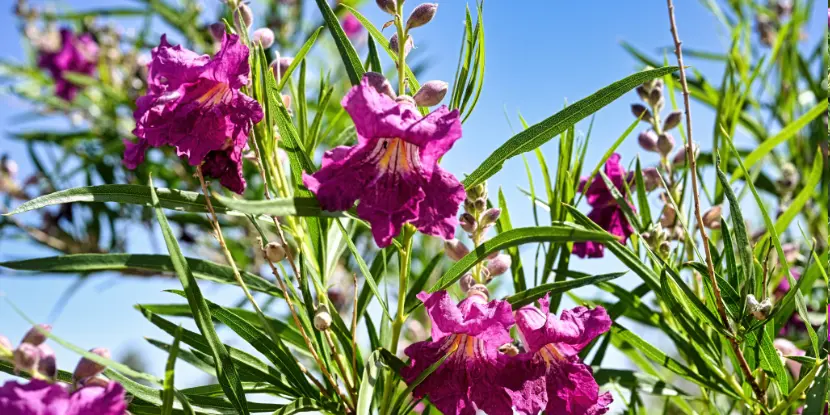
Closeup of a blooming Desert Willow.
Low-Water Shrubs
- Mexican Bush Sage: A low-maintenance shrub producing plumes of purple blooms.
- Texas Ranger: A drought-tolerant shrub with silvery foliage and vibrant purple flowers.
- Chaparral Sage: An aromatic shrub with lavender-blue flowers.
- Oleander: A hardy shrub with colorful flowers in shades of pink, red, white, or yellow.
- Indian Hawthorn: An evergreen shrub with clusters of pink or white flowers.
- Rosemary: A fragrant herb that adds texture to your garden and can be used in cooking.
- Lavender: Another aromatic herb with purple flowers that attract pollinators.
- Manzanita: A native shrub with beautiful red bark and small, urn-shaped flowers.
- Bush Anemone: A low-growing shrub with showy white flowers.
- Sage: An ornamental flowering shrub that attracts hummingbirds and butterflies.
- Coyote Brush: A native shrub that’s highly adaptable to different soil types and requires little water.
- Butterfly Bush: A fast-growing shrub with long spikes of purple, pink, or white flowers.
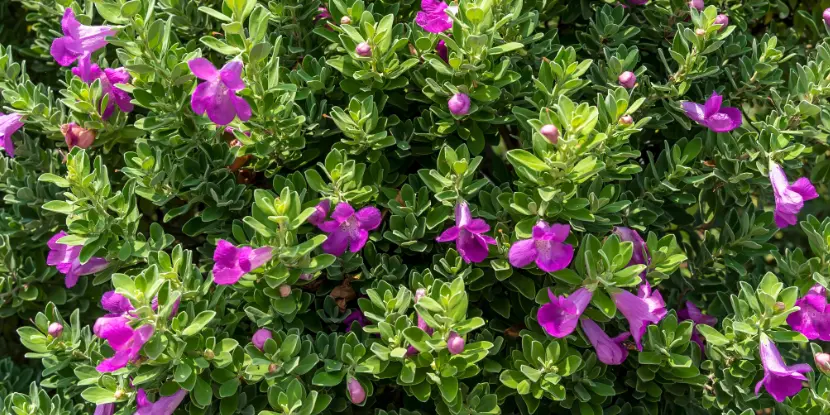
The purple flowers of a Texas Ranger shrub.
Low-Water Ground Covers
Ground covers are low-growing plants that spread horizontally, covering the ground with foliage.
- Succulents: These low-growing plants come in various shapes, sizes, and colors and require minimal watering.
- Ice Plant: A tough ground cover with bright flowers.
- Creeping Thyme: A fragrant herb that provides excellent ground cover for sunny areas.
- Yarrow: A drought-tolerant perennial with white, pink, or yellow flowers.
- Verbena: A creeping ground cover with vibrant purple or red flowers.
- Silver Carpet: A low-growing plant with silver foliage and yellow daisy-like flowers.
- Creeping Rosemary: A low-maintenance ground cover with aromatic leaves.
- Blue Fescue: A drought-tolerant grass with blue-green foliage.
- Lantana: A heat and drought-resistant ground cover with clusters of red, orange, yellow, or pink flowers.

Clusters of purple flowers on a Verbena plant.
Ornamental Grasses
Ornamental grasses are taller, upright plants grown for their attractive foliage, texture, and ornamental seed heads.
- Blue Oat Grass: A hardy and drought-tolerant grass with silvery blue foliage.
- Fountain Grass: An attractive grass famous for its arching, feathery seed heads.
- Cape Rush: An unusual-looking grass with brown flower clusters resembling the head of a mop.
- Deer Grass: A native grass with tall stalks that turn golden in the fall.
- Mexican Feather Grass: A delicate, wispy grass that adds movement and texture to your xeriscape.
- California Fescue: A native bunchgrass with blue-green leaves that work well in dry landscapes.
- Muhly Grass: A pink-flowering grass that adds color to your garden.
- Little Bluestem: A versatile grass with blue-green foliage that turns reddish-orange in the fall.
- Pink Muhly Grass: Renowned for its exquisite pink flowering plumes.
- Little Bluestem: This has blue-green foliage that transitions to a reddish-orange hue in the fall.
- Buffalo Grass: An exceptionally drought-tolerant variety with a soft, fine texture.
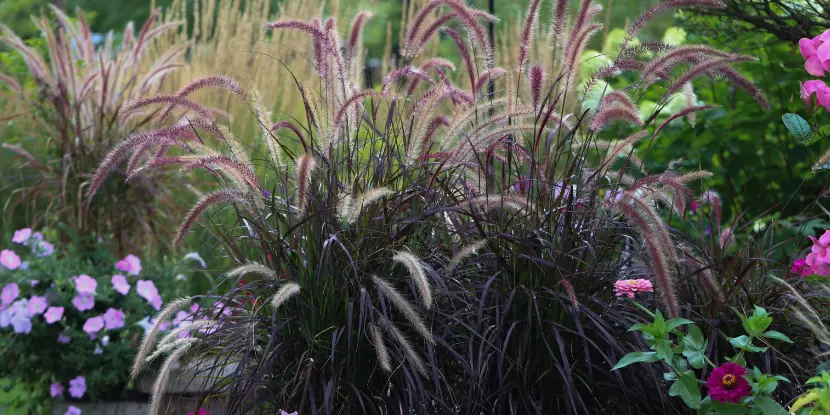
The distinctive plumes of Fountain Grass.
Low-Water Flowering Plants
- California Poppy: This iconic state flower thrives in well-drained soil.
- Matilija Poppy: Also known as the “fried eggplant,” this native perennial features large white flowers with yellow centers.
- Desert Marigold: A tough annual blooming year-round with bright yellow flowers.
- Cleveland Sage: A native shrub with fragrant silvery-gray foliage and lavender-blue flowers.
- Red Bird of Paradise: An eye-catching plant with red and yellow flowers that attract hummingbirds.
- Coneflower: A perennial with large, daisy-like blooms in shades of pink, purple, or white.
- Showy Penstemon: A native plant with vibrant pink to purple flowers attracting hummingbirds and butterflies.
- California Fuchsia: Produces late-summer bright red tubular flowers that are a magnet for hummingbirds.
- Monkeyflower: Provides delicate blooms ranging from yellow to orange and red.
- Black-eyed Susan: A hardy, sun-loving perennial with striking yellow and black flowers.
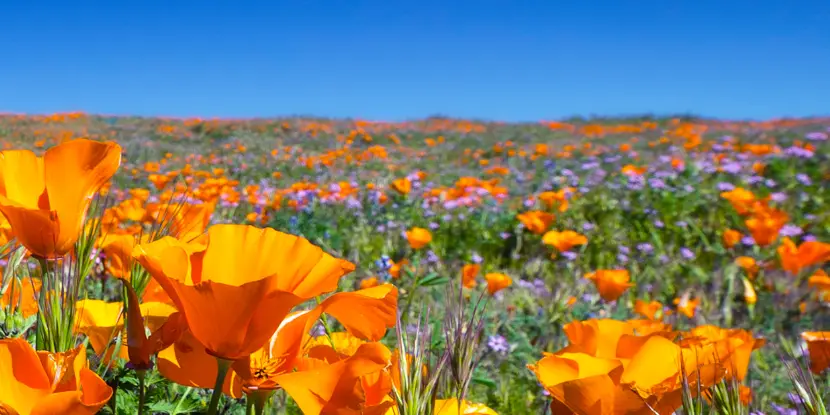
California Poppies in a field.
Succulents
- Red Yucca: A dramatic succulent with tall flower spikes in shades of red or yellow.
- Aloe Vera: This popular succulent has medicinal properties and thrives in dry, sunny conditions.
- Hens-and-Chicks: A hardy rosette-shaped succulent that multiplies quickly and requires little maintenance.
- Sedum: Another low-maintenance succulent with colorful foliage and flowers.
- Agave: With its dramatic, spiky leaves, agave is striking and low-maintenance.
- Jade Plant: A popular houseplant that thrives outdoors in sunny, dry conditions.
- Echeveria: A beautiful succulent with rosette-shaped leaves in a various colors.
- Aeonium: A striking succulent with rosettes of glossy, colorful leaves.
- Paddle Plant: This unusual succulent has flat, paddle-shaped leaves and produces yellow flowers.
- String of Pearls: A trailing succulent with bead-like foliage that looks stunning in hanging baskets.
- Blue Chalk Sticks: A low-growing succulent with blue-gray foliage perfect for ground cover.
- Snake Plant: An easy-to-care-for succulent with tall, sword-shaped leaves in shades of green and yellow.

Commercially grown agave plants.
Cacti
Most cacti are drought-tolerant and bear spectacular, delicate blossoms in the spring. The species native to California include :
- Beavertail Cactus
- Hedgehog Cactus
- Cholla Cactus
- Pincushion Cactus
- Buckhorn Cholla
- Prickly Pear Cactus
- Barrel Cactus
- Strawberry Hedgehog Cactus
- Fishhook Cactus
- Pincushion Cactus
- Teddy Bear Cholla
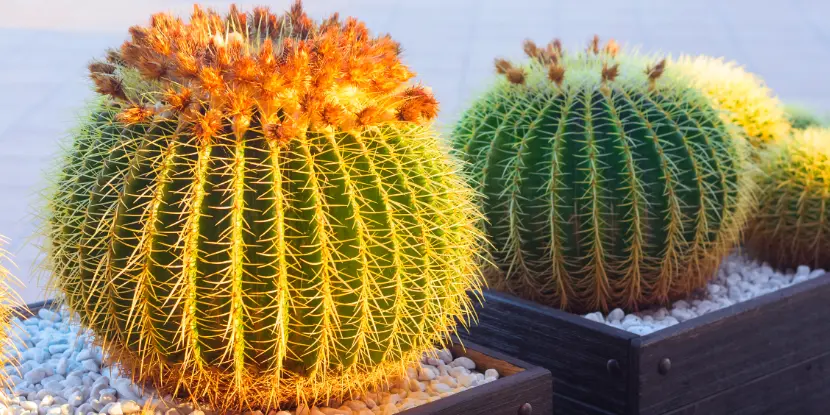
Barrel cacti in bloom.
Maintaining Your Xeriscape
Follow these tips to keep your xeriscape looking its best.
- Watering: Most established xeriscape plants can survive on natural rainfall alone. During droughts, you may have to supplement with watering. Water deeply and infrequently to encourage root growth.
- Mulching: Mulch helps retain moisture in the soil and suppresses weed growth. Use organic mulch, such as wood chips or bark.
- Pruning: Regular pruning keeps your xeriscape neat and promotes healthy growth. Remove dead or diseased branches, and prune back overgrown plants to maintain their shape.
- Fertilizing: Xeriscape plants don’t need much fertilizer, but some may benefit from light feeding during their growing season. Use a slow-release, organic fertilizer to avoid burning the plants.
- Weed Control: Regularly hand-pull or use natural weed control methods to keep weeds at bay without harming your plants. If your xeriscape has a gravel topping, an oscillating hoe (stirrup hoe or hula hoe) is your new best friend.
- Pest Control: Xeriscape plants are less susceptible to pests and diseases due to their hardiness. If you notice any issues, use natural pest control methods to avoid harming beneficial insects and pollinators.
- Seasonal Maintenance: This may include cutting back perennials in the fall or dividing clumping plants every few years.
FAQs: Planning a Xeriscape
Q: Can I still have a colorful garden with xeriscaping?
Xeriscaping doesn’t mean sacrificing color or variety. Many drought-tolerant plants, like California Poppy, Red Bird of Paradise, and Lavender, provide vibrant blooms and lush foliage. By carefully selecting a mix of flowering plants, grasses, succulents, and shrubs, you can create an appealing garden that thrives in low water conditions.
Q: How do I prepare the soil for a xeriscape garden?
Start by removing any existing grass and weeds. Amend the soil with organic matter, such as compost, to improve its structure and drainage. Ensure the soil is well-drained to prevent soggy roots, which can harm drought-tolerant plants.
Q: Can I incorporate hardscaping into a xeriscape garden?
Absolutely! Hardscaping elements like gravel paths, stone patios, and decorative rocks can complement your xeriscape design. These features add texture and visual interest to your garden.
Q: How can I attract pollinators to my xeriscape garden?
To attract pollinators, choose native flowering plants that provide nectar and pollen, such as Cleveland Sage and Showy Penstemon. Provide water sources and shelter to create an inviting habitat for bees, butterflies, and hummingbirds.
Q: Do xeriscape plants require special planting techniques?
Usually, no. However, it’s important to space them appropriately to allow for proper air circulation and growth. Water the plants thoroughly after planting to help establish their root systems.
Q: Can I grow vegetables in a xeriscape garden?
Yes, you can grow certain vegetables. Opt for drought-tolerant varieties like tomatoes, peppers, and eggplants. Apply mulch to conserve soil moisture, and consider planting vegetables in raised beds to improve drainage.
Q: What’s the best time of year to plant xeriscape plants?
During the cooler months of fall or early spring. This allows the plants to establish roots before the hot, dry summer. Avoid planting during extreme heat.
Q: How can I create visual interest in my xeriscape garden throughout the year?
Incorporate a variety of plants with different textures, colors, and blooming periods. Include evergreen shrubs, grasses with winter interest, and late-blooming perennials.
Q: Are there any specific maintenance tools recommended for xeriscaping?
Tools like pruners, hand trowels, oscillating hoes, and weeding knives can help you maintain a xeriscape garden. A drip irrigation system can water your plants efficiently, and a stiff-bristle broom can help keep gravel pathways tidy.
Q: How do I manage invasive plant species in my xeriscape garden?
Monitor your garden and remove any unwanted plants immediately. Use mulch to suppress weed growth and consider planting native species that can outcompete invasives.

